What a time to be alive! Particularly if you’re a fan of big, flashy luxury SUVs. Not only do you have way more of them to choose from than ever before, these days they even fall into neat little categories to make the choice that little bit easier. There are the slow and stately ones that offer up limo-rivalling luxury. There are the tough ones with space-age sensors and serious hardware that let them traverse boulder fields without breaking a sweat. And then there’s the third and arguably most exciting category of the bunch – sports luxury SUVs. It’s not just a matter of stuffing 500bhp into a high-riding 4x4 either; no, the best of this bunch are designed to handle well too. Distil some more and you’ll reach the cream of the crop – SUVs that are just plain, outright fun around a winding road, and which might even sacrifice some traditional 4x4 qualities in this pursuit.
You don’t need to ask where the Cayenne features on the luxury SUV spectrum. It’s a Porsche, and even with just a diesel V6 under its bonnet, boy, does it live up to the name. Its physics-defying abilities got the world talking when it first came around in 2002, but let’s not forget who pioneered the idea of the sporty luxury SUV. It was BMW. The first-generation X5 was unashamedly road biased and famously felt no less agile than a big sedan. The latest one does too, and by that yardstick, the X6 should be even better, right? After all, it’s lower and lighter than its seven-seat sibling and, in India, comes with an even more powerful diesel engine. If driving pleasure is all you crave from your luxury SUV, these two are as sporty as they come, and we’re going to find out which is best.
The wrong fuel?
If you’re a purist who thinks anything sporty must be petrol-powered, and you have your own private stock of 97-octane, you could opt for a Cayenne S, GTS, Turbo or Turbo S instead of the diesel. As for the X6, there are no ‘standard’ petrol versions in India, but BMW sells the full-on 567bhp X6 M.
But like we said, the best sports SUVs should be able to thrill you no matter what powers them, and it’s no secret which fuel is more popular here in India. The original X6 was launched with a petrol V8 and diesel straight six, and when the facelift was introduced towards the end of its life, it came with only a diesel.
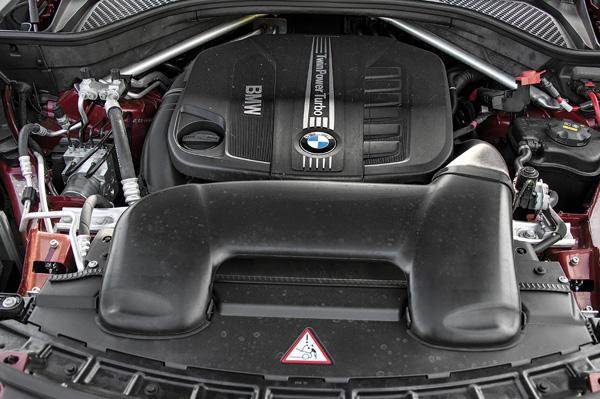
That same engine is back with the second car, and it is a mighty one. There’s 2,993cc spread across six cylinders placed in single file, with two twin-scroll turbochargers bolted on. The result is 309bhp and 64.2kgm of torque from as low as 1,500rpm! In comparison, the Cayenne’s 2,967cc single-turbo V6 doesn’t quite have the numbers to match, making 241bhp and 56.1kgm. Despite what their respective shapes suggest, the Porsche actually weighs 70kg less than the Bimmer, but we doubt that’s going to let it claw back much of an advantage in real-world performance.
The thing is, though, if you drive the Cayenne in isolation, you won’t have much cause for complaint at all. The motor feels smooth, refined and strong enough, whether you’re moving away from rest, cruising or even overtaking. It’s only after you’ve had a taste of the X6 that you’ll notice the Porsche V6 is not as good as a six-cylinder diesel engine can be. For instance, you’ll realise it does feel a little strained for the bulk it has to haul, and sounds it too. It doesn’t rev as freely, but at least you can say that it makes full use of its power band, with not much let-up in power. The thing is, however, the BMW’s twin-turbo straight six is just miles better in every measure. The moment you even feather the throttle, it sets off ferociously and then, once you’ve put your foot down, proceeds to shoot to the redline like no diesel you’ve ever seen. The revs are quick and smooth, the sound it makes is quite nice too, and you soon have to remind yourself you’re in a two-tonne SUV. When you dial it back too, the X6 feels better refined, smoother to respond at part-throttle and easier to modulate. In fact, in this department, it feels like a huge step up from even its single-turbo counterpart used in the X5.
Both cars use their own derivations of ZF’s eight-speed torque-converter automatic, so you’d think they behave about the same, right? Well, not quite, because here too, the Bimmer edges ahead. Yes, the Cayenne’s gearbox is just as quick with its shifts, but it’s not quite as buttery smooth. More significantly for when you’re having a spirited blast through the countryside, though, the Porsche gearbox is a little reluctant to downshift and a bit slower to react. As with the engine, however, this is only when driven alongside the X6; on its own, the Cayenne ’box is still pretty great. Predictably, the BMW is a whole lot faster than the Porsche, getting to 100kph in a barely believable 5.78 seconds! The Cayenne hits the mark 1.62 seconds later, and is also over a second slower from 20-80kph in kickdown.
Shed those kilos
What you really want these two to do, though, is make you feel like you aren’t driving a big, fat 4x4, and given their histories, both cars show a lot of promise. It’s worth noting at the start, however, that the two are sprung quite differently. Of the four suspension options BMW offers internationally, the Indian X6 gets only the Comfort setup. It uses steel springs at the front and air suspension at the rear, but it is adaptive, and so firms up as you put the car in Sport or Sport+ mode. The Cayenne has air springs all around and it too has Comfort, Sport and Sport+ settings. However, separately from this, you can raise and lower the ride height to five different levels, which you can’t in the BMW. Similarly, the Porsche’s engine, gearbox and steering can be put into Sport mode independently from the suspension, whereas in the BMW, it’s all mapped to a single toggle.
From behind the wheel, you’ll find a pretty stark difference in the BMW’s behaviour for each of the drive modes. This being the Comfort suspension, the set-up is inherently soft, and in Comfort mode, it feels too unsettled and wallowy, even at low speeds. Sport or even Sport+ is really the way to go, even for normal driving, as the X6 feels much more composed this way. You’ll still find it a bit fidgety though, and even little lumps in the road transmit into the cabin. This is partially down to the massive tyres (275-section front; 315-section rear) that come with the optional 20-inch wheels, which also cause the car to tramline a fair bit.
The Cayenne’s setup is firmer for sure, and you will feel that in any of the three settings when you hit a sharp bump or steep speedbreaker. The differences in ride quality between the modes aren’t as obvious here, and the good news is that all of them are pretty good. The Cayenne rides flatter and does a much better job of ironing out ruts and bumps than the X6. Even when you’re cruising down the expressway at three-digit speeds, it’s the one that stays more composed; the BMW will move your passengers about a bit inside the cabin. You get the sense that the firmness is for the better, and when you look past that slightly stiff edge, the Porsche has the much better ride overall.
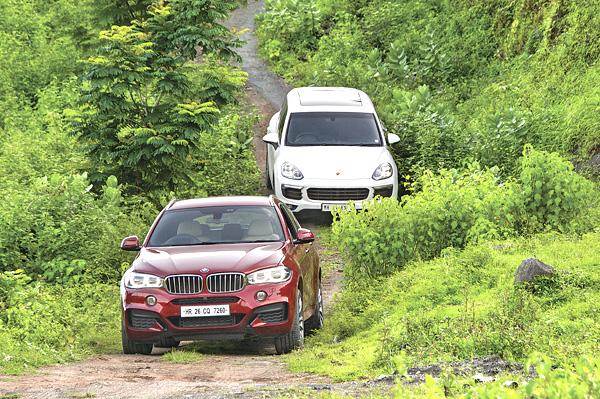
On to the main event – handling – and here’s where the X6’s low-slung roof should give it an advantage in terms of centre of gravity, right? Well, not really, because the two cars are about the same height, believe it or not. Still, this is a BMW, so pin-sharp handling is in its very DNA, surely? Unfortunately, this is not one of the best examples of the breed, and that’s thanks to both, the steering and the suspension setup. Even in Sport+ mode, the steering feels very light and when it does weigh up as you go faster, it feels artificial and seems to put a sponge between your inputs and what the front wheels do. Still, lean it into a corner hard and you’ll at least have a lot of grip from those mammoth tyres, but there’s a disconcerting looseness to the X6’s composure that makes you want to back off. You feel it in the vague steering, in the loads of body roll, and in the way the soft rear end bobs and skips about mid-corner. It’s simply not well sorted enough in this specification. Fingers crossed for the X6 M.
The Porsche Cayenne, as ever, is a superstar on a mountain road. Its steering weighs up nice and progressively, and apart from a small numbness engineered into the centre position for comfort’s sake, it feels quick and sharp as a tack. Aided by the great visibility, the car soon shrinks around you and you can fling it around with immense confidence. Lower the suspension to tarmac-attack height and it gets even better – body roll is superbly contained and it goads you on to push harder and harder. That’s what you want from a driver’s car, and dynamically, the Porsche is clearly the better sorted of the two.
Feel Good Inc.
It’s not good to ruminate long on something as subjective as styling, so we’ll keep it brief. The first-generation X6 was a weird, left-field idea, but it was still cool, and clearly many people agreed, as it was a huge success. The first-generation Cayenne was lauded for its abilities but universally panned for its oddball looks. Amazingly, the roles seem to have been reversed now.
Perhaps it’s because the novelty has worn off, but the X6’s shape just isn’t as impressive anymore. This new car also suffers from BMW’s recent trend of over-styling, and there are just too many creases and bulges all over the place. This is particularly true at the rear, where the chunky haunches and comically large tail-lamps only serve to highlight the large and bulky derriere. The front, admittedly, is a lot nicer, with its aggressive snout and angry-looking full-LED lighting setup. Mind you, the Cayenne won’t win any beauty contests either, but this facelift that came around in December 2014 really improved things. The LED accents in the headlamps and tail-lamps make it look modern and liven things up, as do the subtle bulges in the wheel arches. It’s a simpler-looking SUV, but it’s also a bit more discreet and elegant.
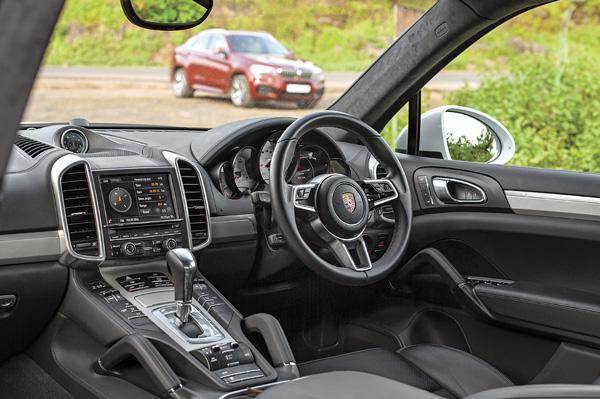
Inside, despite the superb new steering wheel nicked from the 918 supercar, you can’t run away from the Cayenne’s age. The button-heavy, cockpit-like centre console was cool once, but it feels a bit dated, and though it’s nice to have every control mapped to its own button (rather than shuffling through menus), there’s just too many of them. Still, you can adjust the seat to suit any frame and visibility is great too. It’s also heavily customisable in the options list, so you can make it look like no other Cayenne out there.
Of course, the X6 interior does have that BMW family look to it, but it feels a little more special thanks to the optional dual-tone leather, unpolished wood and the racier fittings that come with the standard M-Sport pack. The high-res iDrive screen, digital dials and heads-up display also allow it to feel a lot more modern, and we absolutely love the wide array of seat adjustment, including squab, bolster and shoulder support. Mind you, though the Cayenne we’re driving doesn’t have them, you can find better seats in the options list.
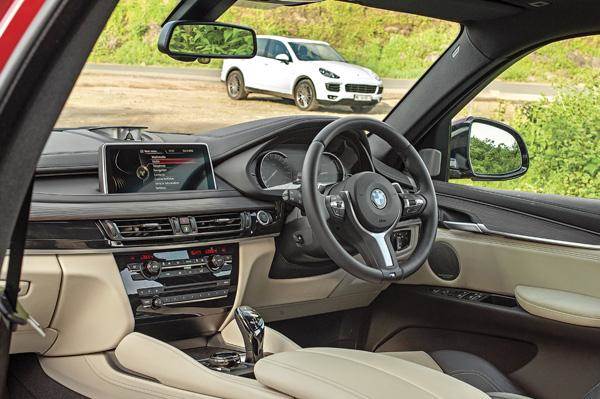
In the back seat, the Porsche has a clear advantage, with added width, better space for a third passenger, and of course, head room and a bigger boot; the BMW’s sloping roof doesn’t allow for much.
Street fighters
In its transition from a niche product into something almost mainstream, the X6 has lost some of its charm. As a luxury item though, it still gives you everything you need, provided you won’t be seated at the back. And no matter where you stand on the styling, you can’t argue that it has a lot of presence. And then of course, there’s that engine, which should be a lesson to all luxury carmakers about how to do a proper sporty diesel. It’s so disappointing then that, dynamically, it doesn’t live up to the drama that its looks and motor promise. It feels soft, soggy and loose, and doesn’t make you want to drive it fast. At Rs 1.15 crore, it also costs Rs 11 lakh more than the Cayenne diesel.
Of course, anyone who knows Porsche will tell you that you can easily shoot the price up by tens of lakhs by playing with the options list, but the truth is the Cayenne now gets all the basics as standard, so you don’t feel as short-changed. And yes, the 241bhp diesel V6 doesn’t do the car justice, but then, you do have the option of a 380bhp twin-turbo diesel V8 for a lot more oomph. What really seals it for the Porsche, however, is the chassis. It’s the better driver’s car by far and does a superb job of putting you right at the heart of the experience. Even if you put the dynamic ability aside, it’s the one that is more spacious and comfortable, and thanks to the variable ride height and diff locks, you could easily venture off road without worry.
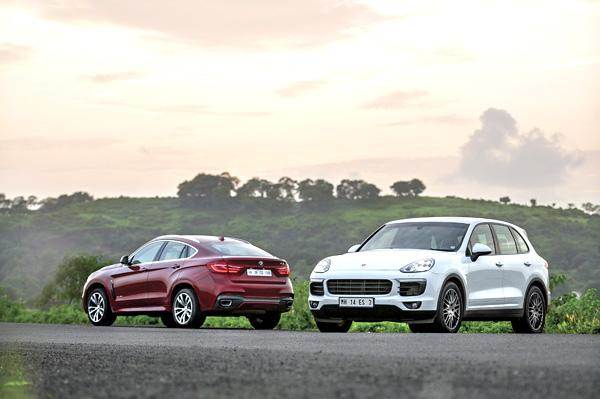
At a considerable premium over conventional luxury SUVs, these cars have to do something special to win your affection. Since sportiness is their bent, it’s where they have to excel. It may be a little plain on the surface, but under the skin, the Cayenne not only outshines the BMW when you’re attacking corners, but also in everyday driving, which is why it’s our pick.

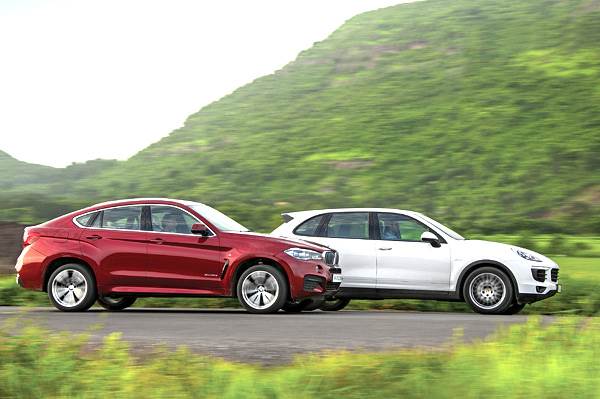
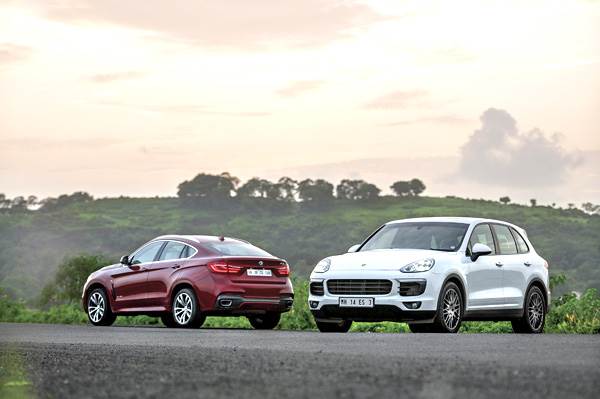
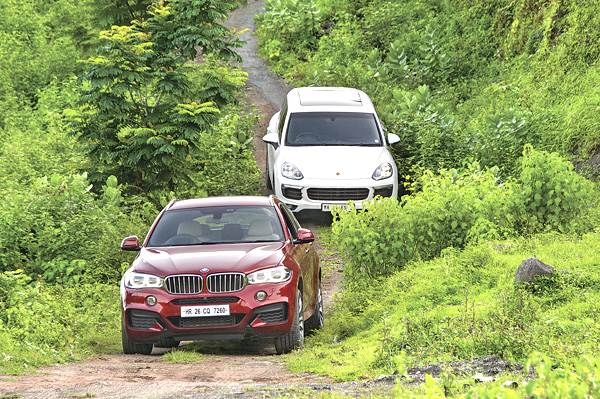



Comments
Member Login
Personal Details
No comments yet. Be the first to comment.